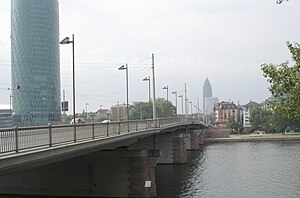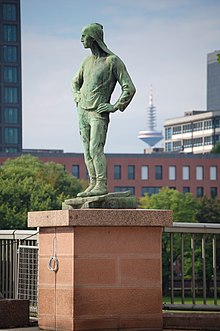Friedensbrücke (Frankfurt am Main)
Coordinates: 50 ° 6 ′ 3 ″ N , 8 ° 40 ′ 1 ″ E
| Peace Bridge | ||
|---|---|---|
| View from Sachsenhausen towards the main train station | ||
| use | Road bridge with tram tracks |
|
| Crossing of | Main | |
| place |
Gutleutviertel Sachsenhausen-Nord (Main km 33.89) |
|
| construction | Composite steel bridge | |
| overall length | 287 m | |
| width | 29.5 m | |
| Headroom | 6.85 m | |
| construction time | 1950-1951 | |
| location | ||
|
|
||
The Friedensbrücke is a road bridge over the Main in Frankfurt am Main . It connects Baseler Platz in Gutleutviertel with Stresemannallee in Sachsenhausen at electricity kilometer 33.890 . It was built from 1950 to 1951 to replace the Wilhelmsbrücke that was built between 1844 and 1848 . At the southern bridgehead stands the bronze sculpture of the port workers created by Constantin Meunier in 1890 . It reminds us that immediately downstream of the bridge on the northern side is the former Frankfurt Westhafen , which was in operation from 1885 to 1999.
The Bundesstraße 44 , the tram lines 12, 16, 17, 20 and 21 as well as the Ebbelwei-Express lead over the Friedensbrücke .
history


From 1844 to 1848 the first railway bridge over the Main was built for the Main-Neckar-Bahn . It was also the second Main Bridge in Frankfurt after the Old Bridge, which dates back to the Middle Ages . The Mainspitze depot existed in the construction site of the bridge's south ramp from 1846 until it opened . It was in the area of what is now the Stresemannallee / Gartenstrasse tram stop . This provisional arrangement resulted in two accidents: On August 16, 1848, the locomotives of two trains ran over the end of the line within a few hours. One fell from the not yet connected access ramp into the construction site of the bridge, killing the locomotive's stoker.
The opening of the first Main-Neckar bridge took place on November 15, 1848 . It was a brick arched bridge with nine arches 17 to 20 meters wide, but one of which was designed as an iron swing bridge to allow river boats, whose mast could not be folded back then, to continue up the Main. This swing bridge was decommissioned in 1867 and replaced by a stone arch. The bridge superstructure was designed for two tracks and was initially only 9.50 meters wide.
With the opening of the main train station in 1888, the introduction of the railway lines to Frankfurt was moved westwards, where the new Main-Neckar bridge was built. The old bridge lost its function and was bought by the city of Frankfurt, converted into a road bridge in 1890/1891 and at the same time widened to 13.36 meters, with the routes of the former access routes being converted into streets. From 1891, the bridge led the new name Wilhelm Bridge by Kaiser Wilhelm I .
The rapid growth of the northern station district also caused the volume of traffic on the bridge to increase rapidly. On July 31, 1897, a horse-drawn tram ran across the bridge for the first time . The tram was electrified just three years later .
In 1908 the Wilhelmsbrücke was widened again to 15.60 meters. With that the capacity of the bridge was exhausted. Already in the thirties it was no longer able to cope with the traffic flows, but a new building was not carried out due to the tense economic situation of the pre-war period.
On March 25, 1945, the bridge, like the other Frankfurt Main bridges, was to be blown up by a command of the Wehrmacht . However, the explosive charge was placed incorrectly, so that the bridge was only slightly damaged. Whether the demolition failed out of intent or negligence is controversial. A day later the advancing troops of the US Army used the Wilhelmsbrücke to march into the city from the south.
The damage to the bridge was provisionally repaired immediately and the Wilhelmsbrücke was used as the Golden Gate Bridge for American supplies. The bridge was initially closed to civil traffic, so that the tram network was initially divided into two sub-networks. In 1946 the bridge was prepared in such a way that it could also be used again for heavy vehicles. Nevertheless, the bridge was no longer able to cope with the volume of traffic. The reconstruction of the Untermainbrücke bridge to the east , which was now also available for tram traffic, did nothing to change this.
As early as September 1949, the volume of traffic had risen to 15,000 vehicles a day, as the important feeder to the A3 and the airport ran over the Wilhelmsbrücke . In November 1949 it was therefore decided to demolish the old Wilhelmsbrücke and build a new one. The MAN plant in Gustavsburg received the order for this .
The demolition of the old bridge began on February 20, 1950, just three days after the contract was awarded. Around 15,000 cubic meters of rubble had to be removed. By June 1950, all of the old pillars had disappeared, and the new construction began at the same time. The inauguration ceremony took place on March 1, 1951. This completed the reconstruction of the Frankfurt Main Bridges. It was not until 1964 that the first new bridge in the urban area was built, the Flößerbrücke .
The new bridge was named Friedensbrücke . It is a 287.32 meter long girder bridge as a steel composite structure that rests on four river pillars. The largest span is 48 meters, the lane width 29.50 meters.
In 1994/95 the Friedensbrücke was completely repaired. The superstructures, the abutments and the pier heads were demolished and rebuilt. The two adjacent superstructures of the composite steel bridge are continuous girders with a two-web T-beam cross- section . The two main girders of the T-beams are airtight, welded steel box girders. The deck is prestressed in the transverse direction . During the construction period, a provisional steel bridge erected downstream next to the bridge took over the car and tram traffic running in the south. From July 2002 to November 2003 a new deep quay was built on the southern bank of the Main, which stretches below the Theodor Stern quay from the Friedensbrücke to the Main-Neckar-Brücke . Remnants of rubble from the renovation as well as foundation remains and wooden foundation piles from the old Wilhelmsbrücke were dredged under the bridge.
Former mooring of the Frankfurt Navy Comradeship
From 1968 to 2001, the berth of the "Heimboot" WBR 7 of the Frankfurt Navy Comradeship was located below the bridge on Theodor-Stern-Kai . The 1943 R127 in service minesweeper of Aldebaran class was after the war until 1956 when German mine clearing service used from 1947 under US flag. From 1956 to 1961 it served as a minesweeper M 1064 Deneb in the 3rd mine clearing squadron of the German Navy , then until 1968 as a houseboat WBR 7 . In November 1968 it was moved to its long-term berth at the Friedensbrücke. In 2001 the berth had to be relocated to Offenbach harbor to make room for the expansion of the deep quay. In September 2006 the boat ran full of water and capsized. The ship was lifted and then scrapped.
See also
literature
- Wolfram Gorr, Frankfurter Brücken , Societäts-Verlag, Frankfurt am Main 1982, ISBN 3-7973-0393-9
- Bernhard Hager, From the history of the Main-Neckar-Bahn, in: Yearbook for Railway History 36 (2004), pp. 5-32.
- Madlen Lorei, Richard Kirn: Frankfurt and the three wild years. 1945-1947. , Societäts-Verlag, Frankfurt am Main 1980, ISBN 3-7973-0357-2
Web links
- The new construction of the Friedensbrücke. Archived from the original on August 11, 2011 ; Retrieved May 7, 2014 .
- Harald reports: Photos of the demolition of the Wilhelmsbrücke and the reconstruction of the Friedensbrücke
- Stadtbrt. Kölle Frankfurt am Main: The widening of the Wilhelmsbrücke in Frankfurt am Main. German construction newspaper from 1909. Commons
References
- ↑ a b Federal Waterways and Shipping Administration: Route Atlas Main I. (PDF 11 MB) (No longer available online.) 2010, p. 41 , archived from the original on January 14, 2015 ; Retrieved January 18, 2015 .
- ^ Fritz Paetz: Data collection on the history of the railways on the Main, Rhine and Neckar . Bensheim-Auerbach 1985.
- ↑ Hager, p. 14
- ↑ WBR7 ex DENEB ex USN141 ex R127 ( Memento from August 17, 2012 in the Internet Archive )
- ^ Frankfurter Allgemeine Zeitung of September 29, 2006



